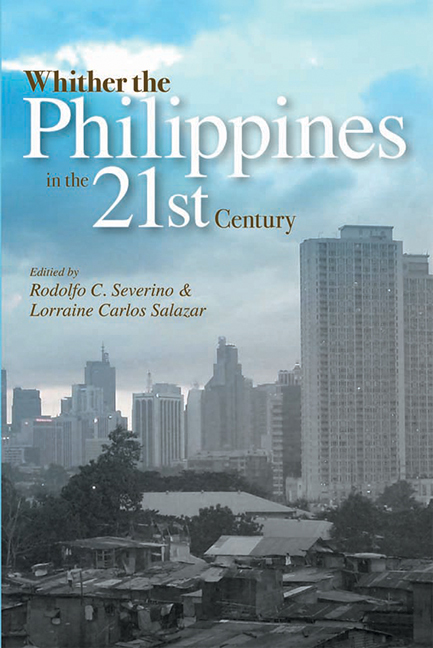Book contents
- Frontmatter
- Contents
- List of Illustrations
- Foreword
- Acknowledgements
- The Contributors
- List of Abbreviations
- Map of Southeast Asia
- 1 The Philippines in Southeast Asia
- 2 From Regime Crisis to System Change
- 3 Proposed Constitutional Reforms for Good Governance and Nation Building
- 4 The Military in Philippine Politics
- 5 Religion and Politics
- 6 The Philippine Press
- 7 Macroeconomic Issues and Challenges
- 8 Investment Climate and Business Opportunities
- 9 Why Does Poverty Persist in the Philippines?
- 10 Diaspora, Remittances, and Poverty
- 11 The Philippine Development Record
- 12 Sancho Panza in Buliok Complex
- 13 The Insurgency That Would Not Go Away
- 14 Whither the Philippines in the 21st Century?
- Index
Foreword
Published online by Cambridge University Press: 21 October 2015
- Frontmatter
- Contents
- List of Illustrations
- Foreword
- Acknowledgements
- The Contributors
- List of Abbreviations
- Map of Southeast Asia
- 1 The Philippines in Southeast Asia
- 2 From Regime Crisis to System Change
- 3 Proposed Constitutional Reforms for Good Governance and Nation Building
- 4 The Military in Philippine Politics
- 5 Religion and Politics
- 6 The Philippine Press
- 7 Macroeconomic Issues and Challenges
- 8 Investment Climate and Business Opportunities
- 9 Why Does Poverty Persist in the Philippines?
- 10 Diaspora, Remittances, and Poverty
- 11 The Philippine Development Record
- 12 Sancho Panza in Buliok Complex
- 13 The Insurgency That Would Not Go Away
- 14 Whither the Philippines in the 21st Century?
- Index
Summary
In 2004 and 2005, the Philippines' gross domestic product grew by 6 and 5.1 per cent, respectively. In the Southeast Asian context, this growth rate places the country behind Singapore and Vietnam, but it compares fairly well with those of Indonesia, Thailand and even Malaysia. Because of this, international credit rating agencies have been upgrading their ratings for the Philippines. Government figures show that, under the administration of President Gloria Macapagal Arroyo, the Philippine economy grew by an average of 4.4 per cent a year, faster than in the three previous presidencies.
Yet, the question in many people's minds is this: why does the Philippines continue to be outside the “radar screens” of most international investors, including those from Singapore and other capital-exporting ASEAN countries? Why has the percentage of the country's population living below the poverty line remained stuck at 30 per cent (in 2003), which, in ASEAN, puts the Philippines in the same league as Cambodia, Laos and Myanmar and worse off than Vietnam (19.5 per cent in 2004)? In spite of the steady macroeconomic growth, why do so many Filipinos have to leave their homeland and their families to seek jobs? If economic growth brings stability and contentment, why do the Philippines' two insurgencies — the communist and the Muslim — so stubbornly persist? Why do Philippine politics appear so volatile? Why do elements of organized religion and the military find it necessary to intervene in the political process?
Is it just a matter of the normal time lag between a macroeconomic surge and its trickle-down effect? Is it a question of unjustified impressions purveyed by media free from undemocratic constraints? Is the problem the country's rapid population growth? Is it the consequence of political decisions? Is it a matter of political will or political institutions? On the other hand, are there niches of progress that are not obvious to many?
- Type
- Chapter
- Information
- Whither the Philippines in the 21st Century? , pp. xi - xivPublisher: ISEAS–Yusof Ishak InstitutePrint publication year: 2007



